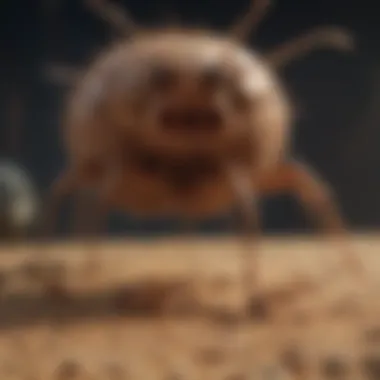Mastering Pharaoh Ant Trap Effectiveness: A Comprehensive Guide


Preventive Pest Control Strategies
When it comes to effectively managing pest infestations, implementing preventive pest control strategies is paramount. Starting with House Exterior Protection, a crucial aspect involves sealing cracks to prevent pests like pharaoh ants from finding their way inside. Additionally, clearing debris around the perimeter of your home is essential in eliminating hiding spots for these tiny intruders. Moreover, implementing measures to stop pests from entering, such as installing door sweeps and screening windows, can significantly reduce the likelihood of infestations. Moving on to Yard Maintenance, regular upkeep of your yard is vital in creating a pest-free environment. Performing essential yard care routines such as trimming bushes, mowing the lawn, and removing standing water helps in preventing pests from establishing colonies near your home. An integral part of pest prevention is Indoor Cleanliness. Expert cleaning tips and techniques like vacuuming regularly, keeping food stored in airtight containers, and fixing leaky faucets can deter pharaoh ants and other pests from invading your living spaces. Garbage Disposal plays a critical role as well; adopting efficient waste disposal methods and ensuring proper garbage disposal not only reduces pharaoh ant attraction but also prevents other pests from feeding on leftover scraps. Lastly, exploring Other Pest Prevention Strategies can unveil innovative ways to safeguard your home, such as utilizing natural repellents, implementing green pest control methods, and investing in pest-resistant materials.
Understanding Pharaoh Ant Behavior
Understanding the behavior of Pharaoh ants is a crucial factor in effectively managing infestations. By delving into their nesting habits, foraging patterns, and reproduction cycle, we gain valuable insights that inform our pest control strategies. This section will cover various aspects of Pharaoh ant behavior to equip readers with the knowledge needed to combat these pests efficiently.
Nesting Habits and Locations
Pharaoh ants have specific preferences when it comes to nesting, typically favoring warm and moist environments. Understanding their preference for such areas is essential in identifying potential nest sites within buildings. This preference stems from the need for a suitable environment to support colony growth and reproduction. While warm, moist areas may promote their abundance, they also pose challenges in locating and eradicating nests effectively.
Foraging Patterns
The foraging patterns of Pharaoh ants reveal their constant search for food sources. This behavior leads to the formation of trails that facilitate communication among colony members. By understanding their foraging habits, we can anticipate their movements and position traps strategically along their trails to intercept them effectively. However, this constant search for food also presents challenges in maintaining control over the ant populations.
Reproduction Cycle
The reproduction cycle of Pharaoh ants revolves around the queen ant's responsibilities and the growth stages of their colonies. The queen's primary role in laying eggs and sustaining colony growth highlights her crucial part in the ant hierarchy. Additionally, understanding the various growth stages of Pharaoh ant colonies sheds light on their population dynamics and the need to target specific developmental phases for effective eradication.
Choosing the Right Pharaoh Ant Traps
In the intricate world of pest control, selecting the appropriate Pharaoh ant traps is a pivotal step in the battle against these persistent insects. The efficacy of ant traps relies heavily on their design and functionality, making the choice of traps a crucial decision in effectively tackling ant infestations. Factors such as bait types, trap materials, and placement locations play a significant role in determining the success rate of trapping efforts. Proper selection can mean the difference between mere containment and total eradication of Pharaoh ant colonies.
Effective Trap Designs
Baits vs. Pheromone-Based Traps


When delving into the realm of effective trap designs for Pharaoh ants, the choice between baits and pheromone-based traps stands out as a key consideration. Baits work by attracting ants with food or liquid substances laced with insecticides, while pheromone-based traps utilize the ants' communication signals to lure them into the trap. The advantage of baits lies in their ability to attract a broader range of ants, including foragers and reproductive ants, thus increasing the trap's effectiveness. On the other hand, pheromone-based traps specifically target worker ants following their scent trails, making them a strategic choice when dealing with established trails and foraging patterns.
Benefits of Multi-Entrance Traps
Multi-entrance traps offer a unique design feature that caters to the intricate foraging behaviors of Pharaoh ants. These traps provide multiple entry points, mimicking natural entryways that ants typically seek out. By offering various entrances, multi-entrance traps increase the likelihood of attracting a larger number of ants into the trap swiftly. Additionally, the presence of multiple entrances reduces congestion at a single point, ensuring smoother ant traffic flow into the trap. This design innovation significantly enhances the trap's efficiency in capturing ants and contributes to a more comprehensive trapping process.
Non-Toxic Options
Safe Trap Materials
Emphasizing the importance of safety in pest control, the choice of safe trap materials aligns with eco-conscious consumer preferences and environmentally friendly practices. Opting for traps made from non-toxic materials ensures that the traps pose no harm to household members, pets, or the natural ecosystem. Safe trap materials incorporate elements that are inert to non-target organisms, focusing solely on attracting and trapping Pharaoh ants without collateral damage. This eco-conscious approach not only prioritizes effective ant control but also addresses concerns regarding chemical exposure and environmental impact.
Eco-Friendly Baits
Eco-friendly baits represent a sustainable solution in the realm of pest management, offering an alternative to traditional insecticides. These baits are formulated using natural ingredients that attract ants without resorting to harmful chemicals. By leveraging environmentally friendly baits, households can combat ant infestations while minimizing their ecological footprint. The use of eco-friendly baits aligns with a holistic approach to pest control, promoting harmony between effective ant elimination and environmental stewardship.
Strategic Placement
High-Traffic Areas
Strategic placement of ant traps in high-traffic areas serves as a fundamental tactic in intercepting Pharaoh ant activity. These areas typically include spots frequented by ants for foraging, such as kitchen countertops, near trash bins, or along baseboards. By targeting high-traffic zones, traps capitalize on the ants' movement patterns, increasing the likelihood of trapping a substantial number of ants. Placing traps in these strategic locations enhances the efficacy of trapping efforts, leading to a more successful containment and extermination of Pharaoh ant populations.
Near Entry Points
Placing traps near entry points where ants gain access to indoor spaces proves advantageous in intercepting ants before they infiltrate living areas. Entry points like cracks, crevices, and gaps in walls or windows serve as vulnerable spots for ant incursions. By positioning traps near these entryways, households create a barrier that intercepts ants before they spread throughout the property. Proximity to entry points allows traps to intercept ants in the early stages of infiltration, preventing widespread infestations and enabling targeted ant control strategies.
Optimizing Trap Usage


Monitoring and Maintenance
Regular Inspection
Regular inspection plays a pivotal role in the efficacy of ant trap deployment. By conducting routine checks on trap conditions and bait levels, homeowners can gauge the effectiveness of their ant control measures. The key characteristic of regular inspection lies in its proactive approach to preempting potential issues before they escalate. This aspect is a popular choice for this article due to its practicality and preventive nature. The unique feature of regular inspection is its ability to detect early signs of infestation resurgence, allowing for prompt intervention. While advantageous in maintaining a pest-free environment, regular inspections may require time and dedication to sustain optimal effectiveness.
Replacing Baits
Another critical aspect of trap maintenance is the timely replacement of baits. Swapping out depleted or spoiled baits ensures that traps continue to attract and eliminate ant populations effectively. Highlighting the freshest bait options, user-friendly baits come in eco-friendly formulations, minimizing environmental impact. The unique feature of replacing baits lies in its ability to sustain trap potency and lure strength over time. Monitoring bait freshness is essential to prevent bait resistance and ensure consistent trap performance. While advantageous in enhancing trap efficiency, frequent bait replacement can incur ongoing costs, requiring budgetary planning to maintain an uninterrupted trapping cycle.
Consistency in Application
Consistency in applying trap optimization techniques is paramount to achieving long-term ant control goals. By adhering to regular trap checks and continuous deployment strategies, households can fortify their defense against persistent ant intrusions. Ensuring routine trap checks allows for timely adjustments and proactive pest management. The key characteristic of routine trap checks lies in their ability to provide real-time feedback on trap efficacy and ant activity levels. This aspect is a beneficial choice for this article, emphasizing the importance of vigilance in maintaining trap functionality. The unique feature of routine trap checks is their adaptability, allowing users to tailor trap strategies to evolving ant behavior for optimal results.
Continuous Trap Deployment
Simultaneously, deploying traps continuously bolsters the trap network's coverage and impact, diminishing ant populations steadily. The cornerstone of continuous trap deployment is its unwavering persistence in tackling ant colonies over extended periods. By strategically placing traps in high-traffic zones and near entry points, households can intercept ant foraging paths effectively. Continuous trap deployment is a popular choice for households seeking a proactive and hands-on approach to pest management. The unique feature of maintaining a constant trap presence is the sustained pressure it exerts on ant populations, gradually reducing their numbers over time. While advantageous in curbing infestations, continuous deployment entails regular trap replenishment and monitoring to sustain its efficacy.
Dealing with Trap Failures
Subsequently, addressing trap failures is crucial in refining trap strategies and overcoming setbacks encountered during ant control efforts. By pinpointing reasons for trap inefficacies and adjusting strategies accordingly, households can iteratively optimize trap performance for better ant eradication outcomes. The focus on trap failure analysis underscores the importance of adaptability and problem-solving in combating resilient ant populations.
Identifying Reasons for Failure
Identifying reasons for trap failures is a fundamental step in diagnosing inefficiencies and fine-tuning trap setups for improved results. The key characteristic of this analysis lies in its diagnostic nature, identifying specific weaknesses in trap functionality or bait attractiveness. Targeting and rectifying these potential failure points enhance the overall effectiveness of ant control measures. This approach is a beneficial choice for this article, emphasizing the need for thoroughness in trap performance evaluation. The unique feature of scrutinizing failure reasons is its ability to highlight systemic issues or environmental factors that impede trap success. While advantageous in problem-solving, identifying failure reasons may entail trial and error processes to identify the optimal trap configurations and bait selections.
Adjusting Trap Strategies


In tandem, adjusting trap strategies based on failure analysis is key to optimizing trap efficacy and outmaneuvering resilient ant populations. By recalibrating bait choices, trap placements, or monitoring frequencies, households can create more targeted and effective trapping environments to combat ant incursions. The pivotal nature of adjusting trap strategies lies in its adaptive response to changing ant behavior patterns and trap performance indicators. This aspect is a popular choice for households seeking to fine-tune their ant control approaches for maximum impact. The unique feature of trap strategy adjustment is its dynamic nature, allowing for ongoing refinements to trap setups and operational protocols. While advantageous in enhancing trap efficiency, adjusting strategies may require ongoing evaluation and experimentation to ascertain the most effective ant management practices.
Supplementary Strategies for Ant Control
In this section of the article focusing on 'Supplementary Strategies for Ant Control,' we delve into the crucial aspects of maintaining a pest-free environment. The importance of supplementary strategies cannot be overstated when it comes to effectively dealing with pharaoh ants. By implementing these additional measures, you can significantly enhance the efficacy of ant traps and create a formidable defense against these persistent pests. We will explore specific practices and tips that not only target existing ant populations but also prevent future infestations from taking root.
Sanitation Practices
Food Storage Tips
Food storage tips are paramount in the fight against pharaoh ants. Properly storing food not only deprives ants of easily accessible food sources but also disrupts their foraging patterns. By implementing measures such as sealing food in airtight containers, keeping countertops clean, and promptly disposing of food waste, you can effectively deter ants from invading your living spaces. The key characteristic of efficient food storage tips lies in their ability to remove attractants that draw ants into your home, thus reducing the likelihood of infestations. While food storage tips may require diligence and consistency, their benefits in mitigating ant problems are unparalleled.
Cleaning Routines
Maintaining a stringent cleaning routine is essential in controlling pharaoh ant populations. Regularly cleaning and sanitizing living areas, especially kitchen and dining spaces, eliminate food residues that attract ants. Sweeping floors, wiping down surfaces, and removing clutter not only eradicate existing ant pheromones but also disrupt their communication channels. The unique feature of thorough cleaning routines lies in their ability to create an inhospitable environment for ants, limiting their access to food sources and nesting sites. While cleaning routines may demand time and effort, their advantages in preventing ant infestations are undeniable.
Sealing Entry Points
Caulking and Sealing Cracks
Sealing entry points such as cracks and crevices with caulking is a fundamental step in ant control. Caulking serves as a physical barrier that prevents ants from infiltrating your home through tiny openings. The key characteristic of caulking lies in its ability to seal off potential entryways, blocking ant pathways and reducing indoor foraging. The unique feature of caulking and sealing cracks is their long-lasting effect, providing a sustainable solution to keeping ants at bay. While caulking may require precision and attention to detail, its advantages in fortifying your home against ant intrusions are significant.
Weatherstripping Doors and Windows
Weatherstripping doors and windows play a vital role in preventing ant incursions. By applying weatherstripping materials to gaps around doors and windows, you create a tight seal that hinders ant entry. The key characteristic of weatherstripping lies in its ability to close off access points that ants could exploit to enter your living spaces. The unique feature of weatherstripping doors and windows is their efficiency in maintaining temperature control while barring ant ingress. While weatherstripping may involve some installation effort, its benefits in enhancing your home's defenses against ants are well worth the investment.
Professional Pest Control Consultation
Benefits of Expert Advice
Seeking professional pest control consultation offers invaluable benefits in ant management. Pest control experts have the knowledge and experience to identify specific ant species, assess infestation severity, and recommend tailored solutions. The key characteristic of expert advice is its personalized approach to addressing ant issues, considering factors unique to each home environment. The unique feature of expert advice is its effective implementation of targeted strategies that achieve long-term ant control. While consulting with pest control professionals may incur certain costs, the advantages of their expertise in safeguarding your home against ants are immeasurable.
Integrated Pest Management Solutions
Integrated Pest Management (IPM) solutions represent a holistic approach to ant control. By combining various tactics such as habitat modification, biological control, and targeted pesticide applications, IPM offers a multifaceted strategy for eliminating ants. The key characteristic of IPM lies in its sustainable and eco-friendly methods that minimize the use of chemicals while effectively managing ant populations. The unique feature of IPM solutions is their emphasis on long-term prevention through proactive monitoring and intervention. While implementing IPM strategies may require coordination and planning, its advantages in promoting overall pest management and environmental wellness are unparalleled.



